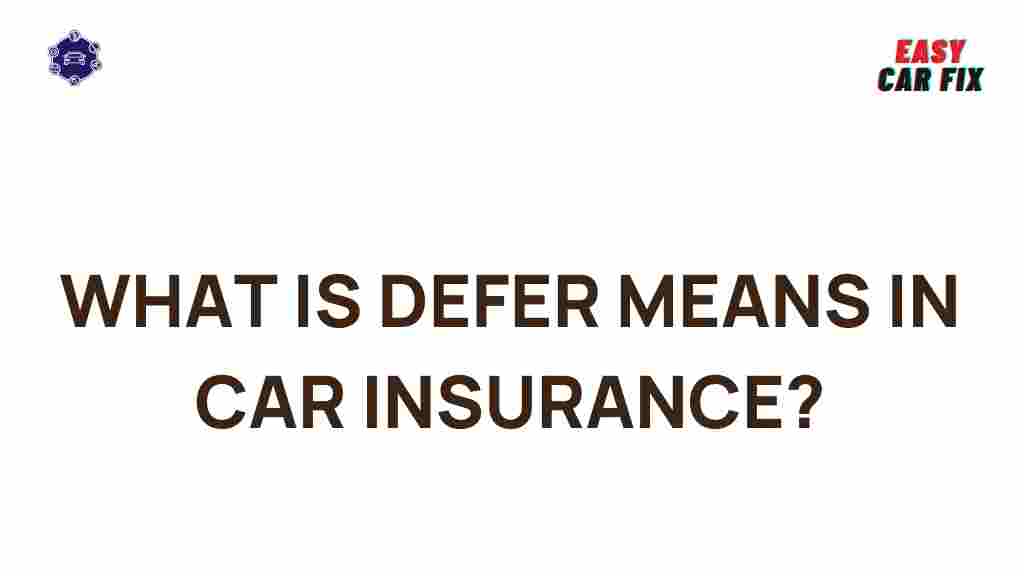Understanding Car Insurance: A Deep Dive into Car Insurance Deductibles
Car insurance is essential for protecting yourself and your vehicle from unforeseen accidents or damage. However, one aspect of car insurance that often confuses drivers is the concept of car insurance deductibles. In this article, we will unravel the mystery of car insurance deductibles, explaining how they work, why they matter, and how you can choose the best deductible for your needs. Whether you’re a first-time buyer or an experienced car owner, understanding car insurance deductibles can help you make better decisions when selecting coverage.
What is a Car Insurance Deductible?
A car insurance deductible is the amount of money you pay out-of-pocket before your insurance coverage kicks in to cover the remaining repair or replacement costs after an accident. The deductible amount is set by the policyholder when they purchase car insurance. It plays a crucial role in determining the cost of your premium as well as your financial responsibility in the event of a claim.
How Do Car Insurance Deductibles Work?
When you file a claim for an accident or damage, your insurance company will assess the situation and calculate the amount needed to cover the repairs or replacement. If your policy has a deductible, the insurer will subtract that amount from the total cost, and you will be responsible for paying the remaining balance. For example, if your deductible is $500 and the damage amounts to $2,000, you’ll pay $500, and your insurer will cover the remaining $1,500.
Types of Car Insurance Deductibles
There are two primary types of car insurance deductibles: comprehensive and collision. Each serves a different purpose:
- Comprehensive Deductible: This applies to damage caused by non-collision events such as theft, vandalism, or natural disasters.
- Collision Deductible: This applies when your car is damaged due to a collision, whether it is with another vehicle or an object like a tree or a pole.
How to Choose the Right Car Insurance Deductible
Choosing the right deductible is a delicate balance between saving money on premiums and managing out-of-pocket costs in the event of a claim. Here’s how you can determine the ideal deductible for your situation:
- Consider Your Vehicle’s Value: If your car is old or has a low market value, a higher deductible might be a good choice to lower your premium costs.
- Evaluate Your Financial Situation: If you can comfortably afford a higher out-of-pocket cost in the event of a claim, you may opt for a higher deductible to save on premiums.
- Think About Your Driving Habits: If you rarely drive or live in an area with low accident rates, a higher deductible might be appropriate. On the other hand, if you’re a frequent driver or in a high-risk area, a lower deductible could be safer.
Step-by-Step Process: How to Set Your Car Insurance Deductible
Setting your deductible is straightforward, but it’s important to understand the implications of your decision. Here’s a step-by-step guide:
- Assess Your Budget: Determine how much you can afford to pay out of pocket in the event of a claim.
- Review Your Vehicle’s Value: If your car is worth less than $5,000, consider a higher deductible to reduce your premium.
- Evaluate Your Risk Tolerance: Weigh the savings in premium against the potential cost of a higher deductible.
- Consult Your Insurance Provider: Speak with your insurer to understand how changing your deductible will affect your coverage and premiums.
- Make Your Decision: Choose a deductible that offers the best balance between affordability and financial protection.
Common Issues with Car Insurance Deductibles
While car insurance deductibles are generally straightforward, there are some common issues that policyholders may face:
- Underestimating Repair Costs: If your deductible is too high, you may find it difficult to pay for repairs that exceed your out-of-pocket limit.
- Not Understanding Policy Limits: Some policies may have limits or exclusions on the type of damage covered, so it’s important to fully review your policy before choosing a deductible.
- Missed Claims: Some drivers may not file a claim for small damages because the deductible amount is too close to the repair cost, leading to out-of-pocket expenses that could have been covered.
Tips for Lowering Your Car Insurance Deductible
If you’re looking to lower your deductible while keeping your premium affordable, here are a few strategies:
- Bundle Your Insurance: Many insurance companies offer discounts if you bundle your car insurance with other policies such as home or renters insurance.
- Install Safety Features: Vehicles with anti-theft devices or advanced safety features may qualify for lower deductibles and premiums.
- Maintain a Clean Driving Record: Safe drivers often qualify for lower rates and more flexible deductible options.
Conclusion
Understanding car insurance deductibles is crucial for making informed decisions about your coverage. By carefully evaluating your vehicle’s value, your financial situation, and your driving habits, you can choose a deductible that strikes the right balance between saving money and ensuring that you’re financially protected in case of an accident. Whether you choose a high deductible for lower premiums or a low deductible for peace of mind, knowing how to navigate this aspect of your policy will ultimately help you secure the best car insurance coverage for your needs.
For more information on how to choose the right car insurance policy for you, visit this detailed guide on car insurance options.
To understand more about how deductibles affect your overall car insurance rates, you can also refer to this external resource on insurance deductibles.
This article is in the category Basic Guides and created by EasyCarFix Team
